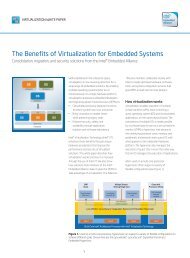Cloud Media Processing - Embedded Community - Intel
Cloud Media Processing - Embedded Community - Intel
Cloud Media Processing - Embedded Community - Intel
You also want an ePaper? Increase the reach of your titles
YUMPU automatically turns print PDFs into web optimized ePapers that Google loves.
To better serve cloud computing customers, media<br />
server vendors (i.e., equipment manufacturers) are<br />
optimizing media processing elements to enhance<br />
performance in these environments. Moreover, mediaoptimized<br />
elements will ease the deployment and<br />
provisioning of media processing capacity, and leverage<br />
virtualization technology to increase the flexibility<br />
and cost efficiencies availed by cloud computing<br />
infrastructure. For instance, web service provider<br />
Amazon offers their Elastic Compute <strong>Cloud</strong> (Amazon<br />
EC2 10 ), where media processing elements could be<br />
optimized for rapid deployment to support on-demand<br />
resizable media processing capacity in the cloud.<br />
Example: <strong>Cloud</strong> <strong>Media</strong> <strong>Processing</strong><br />
for Peak Capacity<br />
A successful service provider offering hosted telecom<br />
services has a growing business and needs to<br />
increase its capacity. Rather than increase capital<br />
expenditures (CapEx) to fund more infrastructure,<br />
the service provider obtains additional capacity<br />
from a cloud service provider during peak demand,<br />
just a few hours a day (Figure 3). When evaluating<br />
cloud service vendors, the telecom service provider<br />
considered network I/O costs, connectivity quality and<br />
overall network performance with respect to jitter,<br />
delay and QoS. Another key aspect was ensuring the<br />
management features could seamlessly integrate<br />
and hand-off calls from the existing infrastructure<br />
to the cloud provider.<br />
The cloud service provider offering included hosted<br />
media servers whose resources were partitioned as<br />
virtualized instances, allowing them to be provisioned<br />
and used, as required, during peak periods. In other<br />
words, the virtualized instances could be activated<br />
and brought online during peak periods, and later<br />
released when demand decreased.<br />
Benefits of outsourcing for service providers:<br />
• Saves capital and operating expenditures<br />
(CapEx/OpEx) to enable future growth.<br />
• Allows media processing resources to<br />
be gradually migrated to the cloud.<br />
<strong>Cloud</strong> <strong>Media</strong> <strong>Processing</strong> | Radisys White Paper<br />
Configure Network<br />
for Normal Traffic<br />
• Service Provider<br />
provisions infrastructure<br />
for normal traffic volumes<br />
Service<br />
Provider<br />
Application<br />
Server (AS)<br />
IP <strong>Media</strong><br />
Server (MRF)<br />
Use IaaS <strong>Media</strong><br />
<strong>Processing</strong> During<br />
Peak Traffic<br />
• Provision and utilize media<br />
processing instances<br />
during peaks<br />
• Service Provider AS routes<br />
overflow calls to cloud<br />
media processing<br />
• Turn off when daily peaks<br />
completed<br />
• Enables tiered-service offerings.<br />
<strong>Cloud</strong> <strong>Media</strong><br />
Services<br />
Provider (IaaS)<br />
Virtualized<br />
<strong>Media</strong> Resources<br />
˸ Premium (highest QoS): uses the service<br />
provider’s internal network and infrastructure.<br />
˸ Economy (satisfactory QoS): uses the cloud.<br />
APIs and Interfaces for <strong>Media</strong><br />
Services—PaaS Model<br />
Service providers are looking for new ways to offer<br />
real-time media processing services, in addition to<br />
hosting their own services. One promising avenue is<br />
to open up their platforms to third party developers,<br />
whose applications would interface with and utilize<br />
their real-time media processing as a service (MPaaS).<br />
This business model could be supported by the public<br />
cloud, which could also handle the billing for third parties.<br />
To pursue this opportunity, service providers must<br />
expose their media service APIs and interfaces in<br />
languages and formats that can be utilized by the<br />
broadest cross-section of the software engineering<br />
industry. The pool of software engineers that develop<br />
applications using SIP or other telecom-specific APIs<br />
make up only a small percentage of the software<br />
Consistent End<br />
User Experience<br />
• Same service quality,<br />
features and performance<br />
24/7<br />
11<br />
PSTN<br />
Phone<br />
2G<br />
Cellular<br />
Laptop<br />
with VoIP<br />
Client<br />
LTE<br />
Smartphone<br />
with App<br />
Figure 3. Outsourcing <strong>Media</strong> <strong>Processing</strong> to Add Capacity During Peak Demand













